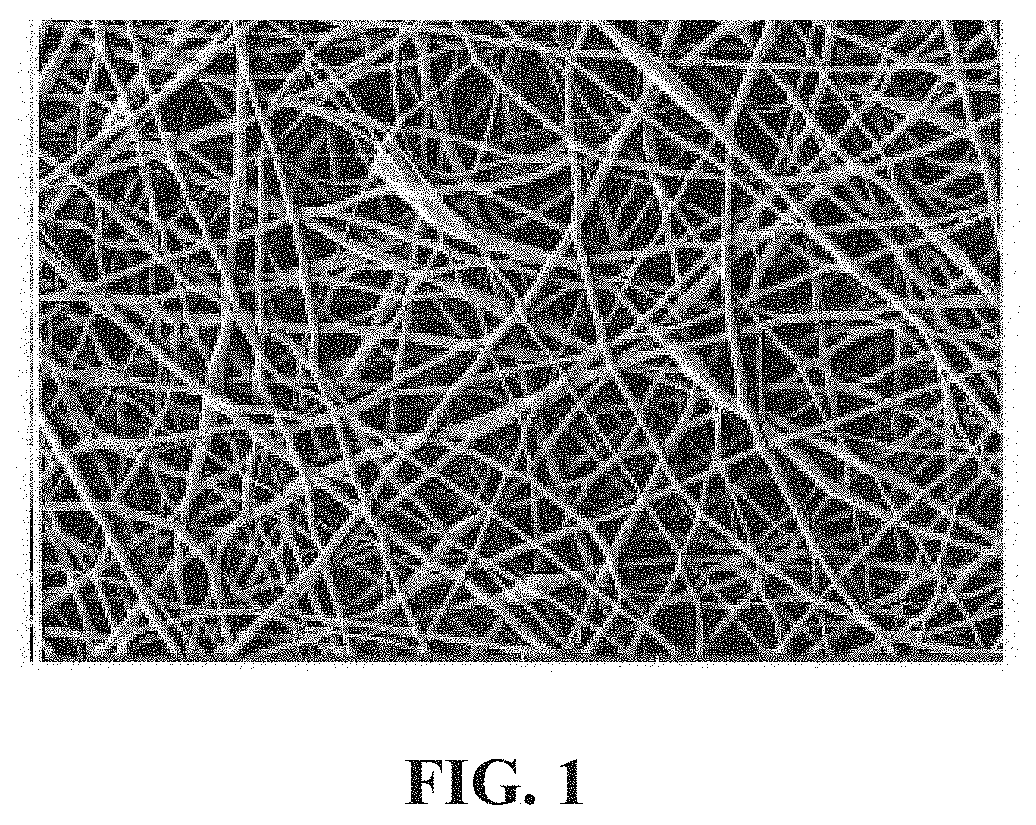Tissue substitute materials and methods for tissue repair
a tissue replacement and tissue technology, applied in the field of nonwoven graft materials, can solve the problems of limited use of allografts in contemporary neurosurgical settings, limited use of allografts, and significant risk of disease transmission, and achieves the effect of facilitating effective and reliable repair of native dura and broad and significant impa
- Summary
- Abstract
- Description
- Claims
- Application Information
AI Technical Summary
Benefits of technology
Problems solved by technology
Method used
Image
Examples
example 1
[0062]In this Example, the performance of a gold-standard xenogenic collagen graft material was compared to an exemplary embodiment of the non-woven graft material of the present disclosure.
[0063]Materials and Methods
[0064]Study Design
[0065]Ten female New Zealand White rabbits (5.0-5.5 months, Western Oregon Rabbit Company, Philomath, Oreg.) were randomized into two groups (I,II) of five animals each (n=5). Group I served as the positive control as all animals underwent bilateral craniotomy and dural resection followed by bilateral surgical repair of the induced dural defects utilizing a collagen graft material (Stryker, Inc. Kalamazoo, Mich.). Group II served as an experimental group as all animals underwent bilateral craniotomy and dural resection followed by bilateral surgical repair of the induced dural defects utilizing the fully resorbable non-biologic non-woven graft material. All animals underwent daily / weekly behavioral assessment and examination for signs of neurotoxicity,...
example 2
[0092]In this Example, the physical properties of the non-woven mesh were determined by direct measurements of mesh fiber, pore size, mass, and dimensions.
[0093]Test articles were cut into four portions of approximately 1 cm2 each. Excised portions were attached to a standard 12 mm SEM stub using double sided carbon tape. Two portions were positioned in a “dimple up” orientation and two portions were positioned in a “dimple down” orientation. Samples were coated with ˜20 Å of gold using a Denton Desk V sputter coater. Physical properties analyzed were average pore size, average fiber diameter, average thickness, side dimension, mass, and “areal density” (g / m2). Dimensional data was collected by recording a series of secondary electron micrographs from each sample using a TESCAN Vega 3 scanning electron microscope. A magnification level of 2 k× was specified for data collection. Images were also collected at 500× magnification. Physical properties were measured directly on the microg...
example 3
[0094]In this Example, the non-destructive testing was conducted on non-woven material of the disclosure.
[0095]Mass was determined by weighing the sample on a balance. Size was measured to include the length and width of the material using calibrated calipers. Area (cm2) was calculated. “Areal density” (g / m2) was calculated using mass and size measurements.
PUM
| Property | Measurement | Unit |
|---|---|---|
| diameter | aaaaa | aaaaa |
| diameter | aaaaa | aaaaa |
| diameter | aaaaa | aaaaa |
Abstract
Description
Claims
Application Information
 Login to View More
Login to View More - R&D
- Intellectual Property
- Life Sciences
- Materials
- Tech Scout
- Unparalleled Data Quality
- Higher Quality Content
- 60% Fewer Hallucinations
Browse by: Latest US Patents, China's latest patents, Technical Efficacy Thesaurus, Application Domain, Technology Topic, Popular Technical Reports.
© 2025 PatSnap. All rights reserved.Legal|Privacy policy|Modern Slavery Act Transparency Statement|Sitemap|About US| Contact US: help@patsnap.com



